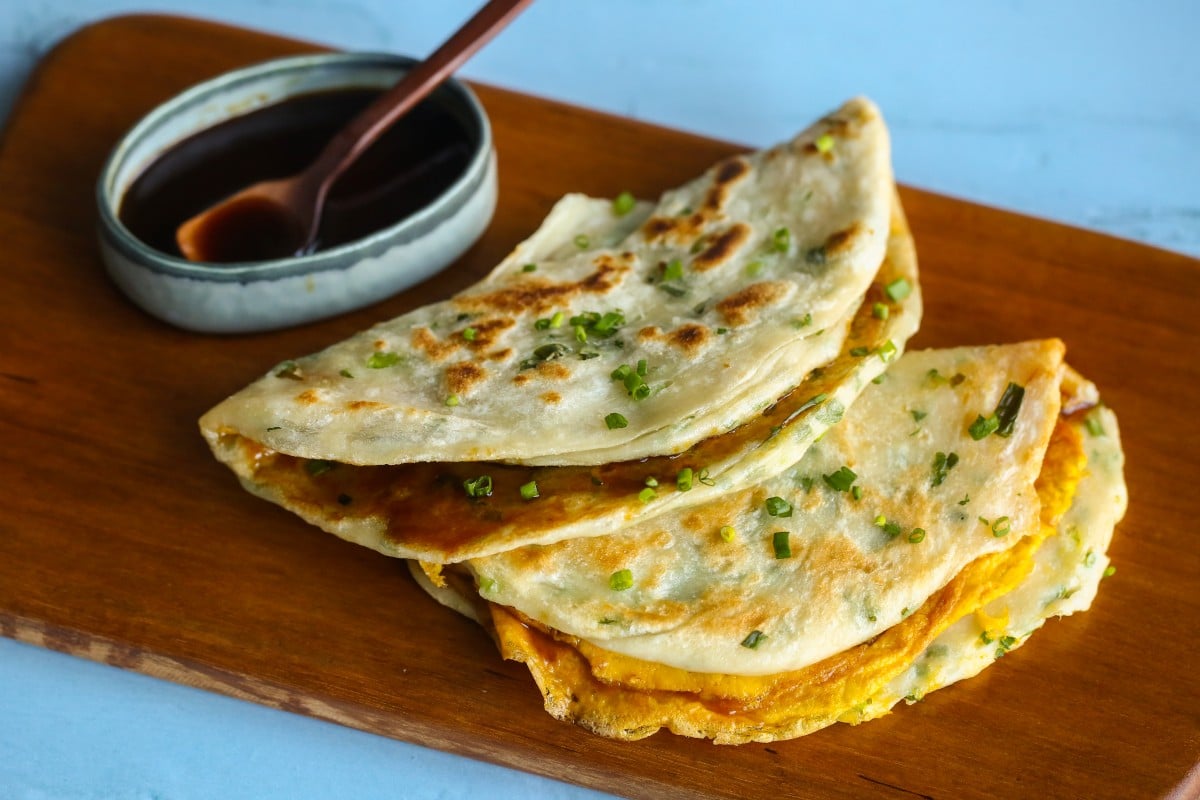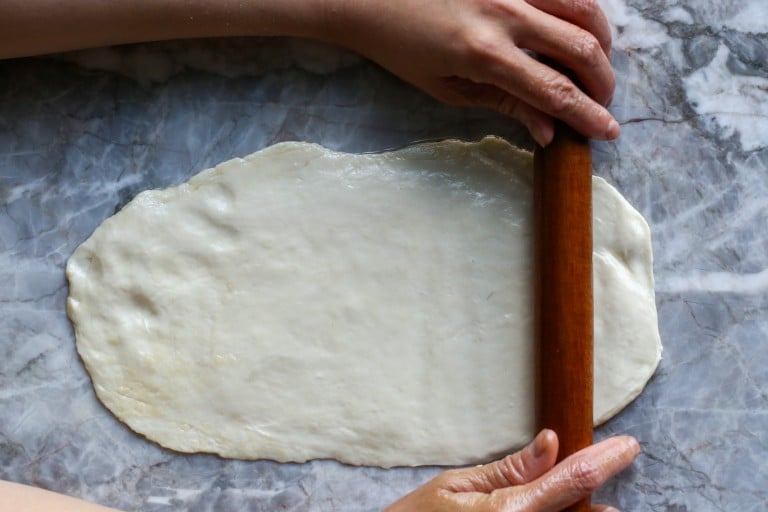
There are several types of cong you bing (spring onion cakes, also spelled chong you bing).
Some shops make delicate, flaky cakes, almost like puff pastry, while the other extreme is hearty, heavy and oily.
The ones I like best are somewhere in between – slightly crisp on the outside, flaky and tender within, and sturdy but pliable enough to use as a wrap.
The most delicious spring onion cakes I’ve ever had were at Tianjin Cong Zhua Bing, on Yong Kang Street, Taipei, Taiwan. The cooks at the roadside stall used an interesting technique to make them flakier: when the cakes were ready on the griddle, they scrunched each one up using a metal spatula and tongs.
In addition to the trick used by the cooks at Tianjin Cong Zhua Bing, the secret to flaky cong you bing is to initially roll the dough so thin that it’s almost translucent. The sheet of dough should then be loosely rolled around the spring onions, trapping air between the layers.
Use a lightly oiled work surface and rolling pin; the oil prevents the layers from sticking together. Do not use flour on the work surface or your hands.
Many recipes will have you mix the flour with hot and cool water without specifying the temperature of the liquid. Instead, I use semi-hot water at 65°C.
I often make a double batch of cong you bing and freeze them, without the sauce or egg (if using). All you need to do is thaw the cakes, then reheat them on a lightly oiled pan placed over a medium-high flame, before serving.

Put the flour in the bowl of a heavy duty mixer fitted with the dough hook. Mix in the salt. With the motor running on low speed, pour in the water. Increase the speed to medium and mix for five minutes. The dough should form a ball and come away from the sides of the mixing bowl, and will be slightly sticky and quite stretchy. (If you want to mix by hand, make a dough with the flour, salt and water, then knead vigorously for about 15 minutes. It will be very sticky at first, but when it’s ready, it will stretchy and just slightly sticky.)

Weigh the dough and divide the weight by six. Split the dough into six even pieces and shape them into smooth, round balls, then place each one on a lightly oiled tray. Rub a little oil over each ball so it’s coated in a thin layer. Cover the dough balls with a clean, dry dishcloth and leave to rest while preparing the sauce.

Put the sauce ingredients in a small pan placed over a low flame and stir until the sugar is dissolved. Taste the sauce – it should be balanced, with savoury, salty and sweet flavours. Correct the seasonings, if necessary, then leave to cool. Finely mince the spring onions.

On the lightly oiled work surface, roll out one piece of dough into a rectangle that’s about 30cmx18cm (12x7in). Scatter ⅙ of the minced spring onions over the rectangle.
Starting at one long end, loosely fold up about 1cm (7/16in) of the entire side, then continue to loosely roll the long end over and over until you reach the halfway point of the rectangle. Start from the other long end and repeat the process.

Pinch the entire length of the dough where the two rolls meet to seal in the spring onions, then gently stretch the dough so it’s about 40cm (15¾in) long. With your left and right hands working simultaneously, start coiling the far ends of the dough towards the centre, until they meet. Twist one of the coils so the two form a figure 8, then place one coil on top of the other and press gently. Place the coil on the work surface and shape the other pieces of dough the same way.

Cook the cong you bing immediately after shaping all the dough balls (if you wait too long, the moisture from the spring onions will seep through the layers). Heat a skillet about 20cm (8in) in diameter, and preferably black cast iron, over a medium flame. Pour about 10ml (2tsp) of oil into the skillet and continue to heat. Quickly roll out one piece of dough so it is 3mm (⅛in) thick and about 18cm (7in) in diameter and lay it on the hot pan. Cook until the bottom is starting to set and is pale golden in spots, then turn it over.
Flip the cong you bing quite frequently, adjusting the flame as needed; don’t let it brown too quickly or get overly dark, which would make the exterior too hard.
Add more oil to the skillet when necessary. After about four minutes, use two spatulas (or a spatula and tongs) – one held in each hand – to roughly press the opposite sides of the cake towards the centre, to fluff up the layers. Turn the cake slightly and repeat the pressing process several times – this should be done quickly. Adjust the heat to high and brown both sides of the cake; they need five to six minutes in total to cook. Cook the remaining cakes the same way.

Brush the sauce on one side of the cong you bing, fold in half and eat hot.

If you like, whisk an egg while the cong you bing is still in the skillet. When it’s fully cooked, lift the cake and pour the egg into the skillet. Immediately place the cake on top and cook until the egg is set. Brush the egg-side of the cake with the sauce before folding in half to eat.